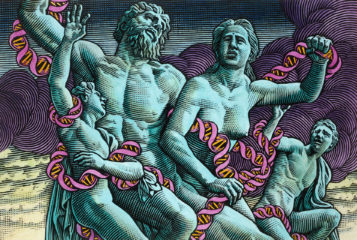| Christmas Lectures: Life Fantastic
Presented by Dr Alison Woollard Organised by the Royal Institution of Great Britain, 14-19 December 2013 Broadcast by BBC4, 28-30 December 2013 |
 |
In the first of three Christmas lectures with the theme 'life fantastic' from the Royal Institution, Dr Alison Woollard answers the ever-important question: 'where do I come from?'.
But the odds of anyone switching over to BBC4 were slim as the young intended audience had a festive TV schedule lined up elsewhere, with films and programmes such as Madagascar, Star Wars and Keeping Up with the Kardashians vying for their attention. (For those who are not familiar with Keeping Up with the Kardashians, it is an Attenborough-esque documentary series that follows the life of quasi-intelligent mammals as they go about their daily routine).
But the live experiments of the Christmas lectures still appealed to me, and the teenage relatives I was watching the show with. I still get excited over demonstration-based science as I did back when I was a schoolboy; the experiments were the only times I looked away from the clock when counting down the minutes left until the end of the school day.
However, it was experiments like seeing potassium explode in water and hair standing on end with a Van der Graaff generator rather than watching cells slowly divide that got me interested in the wonders of the world. Yet I found myself looking over Dr Woollard’s shoulder to see just that.
The audience were told to keep track of worm embryo development and count the number of cell divisions as the lecture was given. Her worms were the stars of the show and were used to demonstrate how a single cell develops into a full organism with every type of cell knowing what they have to do. We were also presented with a video of a beating heart cell and, my favourite, the vein imaging device (if this didn't get the kids interested in science then nothing would).
However, the gestural interface machine, which allowed Dr Woollard to control the movement of 3D graphics of proteins just by the movement of her hand in the air, was an anticlimax. You also know you’ve reached the limit of demonstration-based biology when a cow's leg is trollied in and back out again 50 seconds later without really being needed (and yes, I did time it).
It also felt as if I was back in the classroom. I needed the jump from the confetti cannon half way through the lecture rather than at the beginning. It's difficult for the public to stay focused when you're talking about science but you are likely to lose viewers when you add history as well.
Dr Woollard's passion for the subject was clear to see, but her enthusiasm saw too many topics being addressed in the hour. The pace almost left me wishing the programme was on ITV where there are breaks for adverts. Before anyone could get their heads around what proteins are and their significance, Dr Woollard moved onto genetics.
It was obvious that this was Dr Woollard's first public performance in front of a young audience. She tried to build a relationship through jokes, but while the members of the audience were very bright, they did not even snigger at the quip that developmental biology is feminist because it uses terms such as 'daughter' and 'mother' cells.
There was also a lot of scientific terminology that could have been simplified, such as when an assistant explained how a heart cell was developed in the lab. That time, Dr Woollard did manage to translate for the layman: but through the rest of the lecture, it was a shame no one was there to simplify for her. In a similar way to the unneeded cow's leg, she came out with jargon even when it wasn’t necessary, like mentioning the worm in the photo was DAPI stained and highlighting that the assistant was poking her finger in the dorsal aorta of the heart.
Dr Woollard could learn something from Sir Paul Nurse who appeared in a brief cameo near the end of the lecture. He was a highlight for me and my teenage relatives. In an engaging way, he explained how understanding mutation in yeast cells can help understand and develop therapy for cancer-causing mutations in humans.
Unsurprisingly, Dr Woollard did a good job showcasing the science of where life starts and develops. But I felt the lecture was for an audience who already have a general interest in science and a degree of familiarity with biology and not the average British teen. But maybe that's why it was shown on BBC4 rather than BBC1.





Leave a Reply
You must be logged in to post a comment.